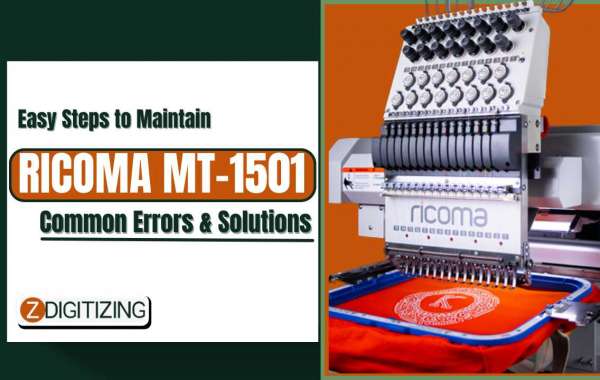Embroidery enthusiasts and professionals rely on sophisticated machines like the Ricoma MT-1501 to bring creative designs to life. However, even the most advanced embroidery machines can encounter common errors that might disrupt the stitching process. In this comprehensive guide, we explore the common errors associated with the Ricoma MT-1501 and provide easy-to-follow solutions along with essential maintenance steps to ensure a seamless and efficient embroidery experience.
Decoding the Ricoma MT-1501: An Overview
Key Features of the MT-1501
The Ricoma MT-1501 boasts features designed to cater to the diverse needs of embroiderers:
Single Head Design:
- The single-head design provides efficiency for smaller-scale projects, making it ideal for intricate or monogrammed designs.
Large Embroidery Area:
- Despite its single-head configuration, the ricoma embroidery machine offers a spacious embroidery area, accommodating various project sizes and types.
User-Friendly Interface:
- An intuitive touchscreen interface simplifies design selection, customization, and machine control, ensuring ease of use for both beginners and experienced embroiderers.
Automatic Thread Trimming:
- The machine's automatic thread trimming feature enhances efficiency, minimizing manual intervention and ensuring clean, precise finishes.
Common Errors with the Ricoma MT-1501
1. Thread Breaks or Shredding
Common Scenario: Thread breaks or shredding during embroidery can lead to imperfect designs and disruptions in the stitching process.
Possible Causes:
- Tension Issues:
- Incorrect tension settings on the machine can cause thread breaks. Ensure proper adjustment for the type of thread and fabric being used.
- Damaged or Poor-Quality Thread:
- Using damaged or low-quality thread can contribute to thread breaks. Always opt for high-quality, compatible thread.
Troubleshooting Steps:
- Regularly check and adjust tension settings according to the thread and fabric specifications.
- Use reputable, high-quality thread to minimize the risk of breakages.
2. Needle Breakage
Common Scenario: Needle breakage can disrupt the embroidery process and potentially damage the machine.
Possible Causes:
- Incorrect Needle Type or Size:
- Using the wrong needle type or size for the chosen fabric can lead to breakage. Ensure the needle is appropriate for the fabric being embroidered.
- Dull or Damaged Needles:
- Dull or damaged needles are prone to breakage. Regularly replace needles to maintain their sharpness.
Troubleshooting Steps:
- Select needles based on the fabric type and weight.
- Replace needles at regular intervals, especially if they show signs of wear or damage.
3. Bobbin Issues (Jamming or Running Out)
Common Scenario: Bobbin-related issues, such as jamming or running out, can cause disruptions in the embroidery process.
Possible Causes:
- Incorrectly Wound Bobbin:
- Bobbins wound unevenly or too tightly can lead to jamming. Ensure bobbins are wound evenly and with the correct tension.
- Dirty Bobbin Area:
- Accumulated lint and debris in the bobbin area can cause jamming. Regularly clean the bobbin area to prevent issues.
- Insufficient Bobbin Thread:
- Running out of bobbin thread during embroidery can interrupt the process.
Troubleshooting Steps:
- Wind bobbins evenly and with the appropriate tension to prevent issues during embroidery.
- Clean the bobbin area regularly, removing lint and debris.
- Monitor bobbin thread levels and replace bobbins before they run out.
4. Uneven Stitching or Gaps in Designs
Common Scenario: Uneven stitching or gaps in designs can compromise the quality and appearance of the final embroidery.
Possible Causes:
- Hooping Issues:
- Improper hooping can lead to uneven tension and stitching. Ensure that the fabric is securely and evenly hooped.
- Stabilizer Selection:
- Incorrect stabilizer selection for the fabric type can result in gaps or uneven stitching. Choose the appropriate stabilizer for the fabric.
- Design Digitizing:
- Poorly digitized designs may cause irregular stitching. Use high-quality digitized designs for optimal results.
Troubleshooting Steps:
- Pay careful attention to hooping, ensuring that the fabric is taut and even.
- Choose the correct stabilizer for the fabric being embroidered.
- Invest in well-digitized designs or improve digitizing techniques for more consistent results.
Easy Maintenance Steps for the Ricoma MT-1501
1. Regular Cleaning and Lubrication
Cleaning:
- Clean the machine regularly, removing dust, lint, and debris from the bobbin area, needle plate, and other components.
- Use a small brush or compressed air to reach tight spaces and prevent the accumulation of lint.
Lubrication:
- Follow the manufacturer's guidelines for lubricating the machine's moving parts. Proper lubrication ensures smooth operation and reduces friction.
2. Check and Adjust Tension Settings
- Regularly check and adjust tension settings based on the thread and fabric being used. Tension adjustments may be necessary when switching between different fabrics or thread types.
3. Needle Maintenance and Replacement
- Inspect needles regularly for signs of wear, damage, or dullness. Replace needles at the first indication of any issues.
- Use the correct needle type and size for the fabric being embroidered.
4. Bobbin Care
- Wind bobbins evenly and with the appropriate tension to prevent issues during embroidery.
- Keep an eye on bobbin thread levels and replace bobbins before they run out.
5. Hooping Techniques
- Practice proper hooping techniques to ensure even tension and prevent distortion of the fabric.
- Adjust the hoop tension according to the fabric type and thickness.
6. Regular Software Updates
- If the machine is computerized, ensure that the software is up to date. Regular updates may include performance enhancements and bug fixes.
7. Professional Servicing
- Schedule periodic professional servicing to address any potential issues and ensure the longevity of the machine.
- If you are looking for digitizing services to convert image to embroidery file free, Then ZDigitizing is best choice for you. Zdigitizing is a professional company that provides complete digitizing and vector art services worldwide.
Conclusion: Mastering the Embroidery Craft
The Ricoma MT-1501 embroidery machine, with its single-head design and advanced features, is a valuable tool for embroiderers seeking precision and efficiency. By understanding common problems and implementing easy maintenance steps, users can ensure a seamless embroidery experience and unlock the full potential of the MT-1501.
Embroidery, as an art form, demands both creativity and technical proficiency. The Ricoma MT-1501 bridges these elements, allowing embroiderers to bring their visions to life. By addressing and preventing common issues and maintaining the machine with care, users can enjoy a continuous journey of creating stunning, high-quality embroidery with the MT-1501.










